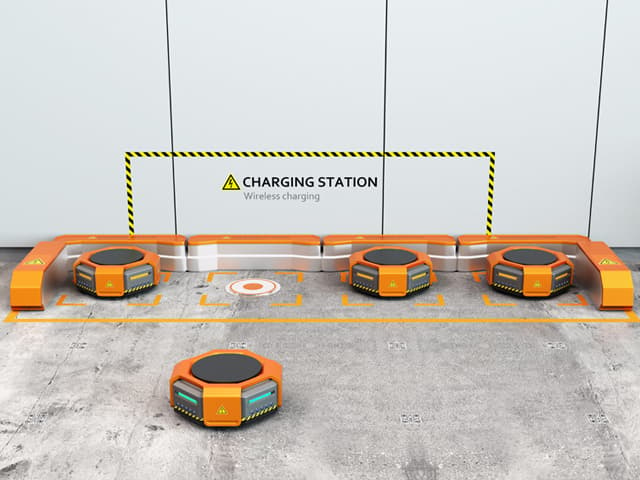Wireless Power Transmission (WPT) Testing Services
Eliminate power limitations in your wireless devices with comprehensive Wireless Power Transmission (WPT) testing. We’ll help you navigate complex regulatory requirements while ensuring your innovative charging solutions – from mobile devices to electric vehicles -- are safe, compliant, and market-ready. Our comprehensive testing portfolio and specialized expertise help you to deliver convenient, cable-free power that meets global standards.

What is Wireless Power Transmission (WPT) Testing at Element?
Wireless Power Transmission is the transfer of electrical energy to devices without physical connections. This technology eliminates the need for cables and batteries, increasing mobility, convenience, and safety for users. At Element, we provide specialized testing and certification services for WPT technologies across both near-field applications like inductive charging and far-field solutions using electromagnetic radiation. Our experts ensure your wireless power innovations perform as intended while meeting strict regulatory requirements for RF exposure and electromagnetic compatibility.

What Can Element Offer You For WPT Testing Services?
Key tests offered
Key tests offered
Element's comprehensive WPT testing services focus on the critical aspects of wireless power systems to ensure both functionality and safety. We conduct detailed electromagnetic compatibility assessments to verify your device operates as intended within its allocated RF spectrum. Our specialized RF exposure testing measures and evaluates Specific Absorption Rate (SAR) and Power Density to ensure compliance with stringent human safety regulations, while our performance testing confirms your WPT system delivers power efficiently.
- Electromagnetic compatibility (EMC) testing
- RF exposure and SAR measurements
- Power transfer efficiency evaluations
- Coexistence testing with other wireless technologies
Products we test
Products we test
We evaluate a comprehensive range of WPT-enabled products, from everyday consumer devices like smartphones and electric toothbrushes to more specialized applications including electric vehicle charging systems and implantable medical devices. Our testing capabilities cover both near-field inductive coupling systems and far-field radiative techniques using microwave or laser technology, ensuring your specific power transmission solution is thoroughly assessed.
- Consumer electronics with wireless charging capabilities
- Electric vehicles and charging infrastructure
- Medical devices with continuous wireless power transmission requirements
- Industrial applications using WPT technology
- Drone aircraft with wireless power systems
Methods and solutions offered
Methods and solutions offered
We provide tailored testing approaches that address the unique challenges of your specific WPT technology. Our experts develop comprehensive test plans that cover regulatory requirements across multiple global markets, maximizing efficiency by identifying opportunities to consolidate testing where possible. We offer detailed compliance strategies that fulfill multiple regulatory frameworks simultaneously, allowing you to bring your innovative WPT solutions to market faster and more cost-effectively.
- Customized test plans for specific WPT technologies
- Compliance strategies for multiple regulatory frameworks
- Performance optimization recommendations
- Pre-compliance testing and consultation
- Technical documentation support for certification submissions
Regulatory expertise you can trust
Regulatory expertise you can trust
Navigate complex global regulations with confidence through our comprehensive understanding of WPT requirements worldwide. Our team stays at the forefront of evolving standards within the International Telecommunications Union (ITU) framework, which harmonizes requirements globally to ensure products designed for one market will technically comply when used in another, and across regional variations. As a Notified Body for European regulations, an Approved Body for UK requirements, a TCB for the US, an FCB for Canada, and a CAB for Japan, we provide the authoritative expertise you need to achieve compliance in all your target markets.
Cutting-edge equipment we use
Cutting-edge equipment we use
Our state-of-the-art laboratories are equipped with specialized measurement systems designed specifically for the unique challenges of WPT testing. We utilize advanced EMC chambers, precise RF measurement equipment, and specialized SAR testing apparatus that can accurately assess power density and absorption rates across various frequencies and power levels. This comprehensive technical capability ensures your wireless power solutions are evaluated thoroughly using the most accurate and reliable methods available.
- Specialized EMC testing chambers
- Advanced SAR measurement systems
- High-precision RF field strength analyzers
- Power transfer efficiency measurement equipment
Which labs offer this service
Which labs offer this service
Our team operates from tech hubs across the world, providing global access to our expert capabilities. Find your nearest Connected Technologies hub on our Locations Page.
Standards we test to and products we test
- European Radio Equipment Directive
- European EMC Directive
- UK Radio Equipment Regulation
- UK EMC Regulation
- IECEE CB Scheme
Consumer electronics
- Smartphones and tablets
- Electric toothbrushes
- Induction cooking appliances
- Wireless charging pads and stations
Medical devices
- Implantable medical devices
- Artificial cardiac pacemakers
- Wearable health monitoring systems
Automotive and transportation
- Electric vehicles
- Wireless EV charging systems
- Drone aircraft with wireless power systems
Industrial applications
- RFID tags and systems
- Wireless power for hazardous environments
- Remote sensing equipment
Your Challenges, Our Solutions
Complex global compliance requirements
Strict RF exposure limits
Technical complexity
Time & cost pressures
Element Experts at your service
Why Choose Element

Global regulatory expertise
Specialized WPT knowledge
Comprehensive testing solutions
Industry-leading facilities
Frequently asked questions
What is the difference between near-field and far-field WPT?
Near-field WPT uses inductive coupling for short-range applications like charging phones and electric toothbrushes. Far-field WPT uses electromagnetic radiation (microwaves or lasers) for longer-distance applications such as solar power satellites and wireless-powered drones. Element provides testing services for both technologies to ensure compliance with relevant standards.
How has WPT technology evolved over time?
WPT technology has evolved significantly over many years, only recently becoming miniaturized enough to be embedded in the smallest devices. With growing global initiatives for electric vehicles, convenient charging solutions like WPT are increasingly vital. The technology continues to advance, enabling new applications across consumer, medical, and industrial sectors.
What devices use near-field WPT?
Inductive coupling is the most common near-field WPT method, used in applications like charging phones, electric toothbrushes, and RFID tags. It also enables induction cooking, continuous wireless power for implantable medical devices (such as pacemakers), and wireless charging for electric vehicles.
What devices use far-field WPT?
Far-field, or radiative, WPT transfers power over long distances using electromagnetic beams, such as microwaves or lasers. This technique is used in applications like solar power satellites and wireless-powered drone aircraft.

Explore our global network of labs and find your nearest location
VIEW ALL LOCATIONSRelated services

RED Directive Testing for CE Marking
Element's Radio Equipment Directive (RED) services provide testing, certification, and expert guidance to help manufacturers meet EU compliance requirements and secure CE marking for wireless products.

Radio Frequency (RF) Testing & Certification Services
Accelerate time-to-market with Element's end-to-end RF testing and certification services. Our expert engineers ensure your wireless devices meet global regulations, prevent interference issues, and perform optimally.

Electromagnetic Compatibility (EMC) Testing & Electromagnetic Interference (EMI) Testing & Certification
Element provides accredited EMC and EMI testing and certification services, helping businesses meet regulatory requirements, reduce costly redesigns, and bring products to market faster through expert compliance support.


